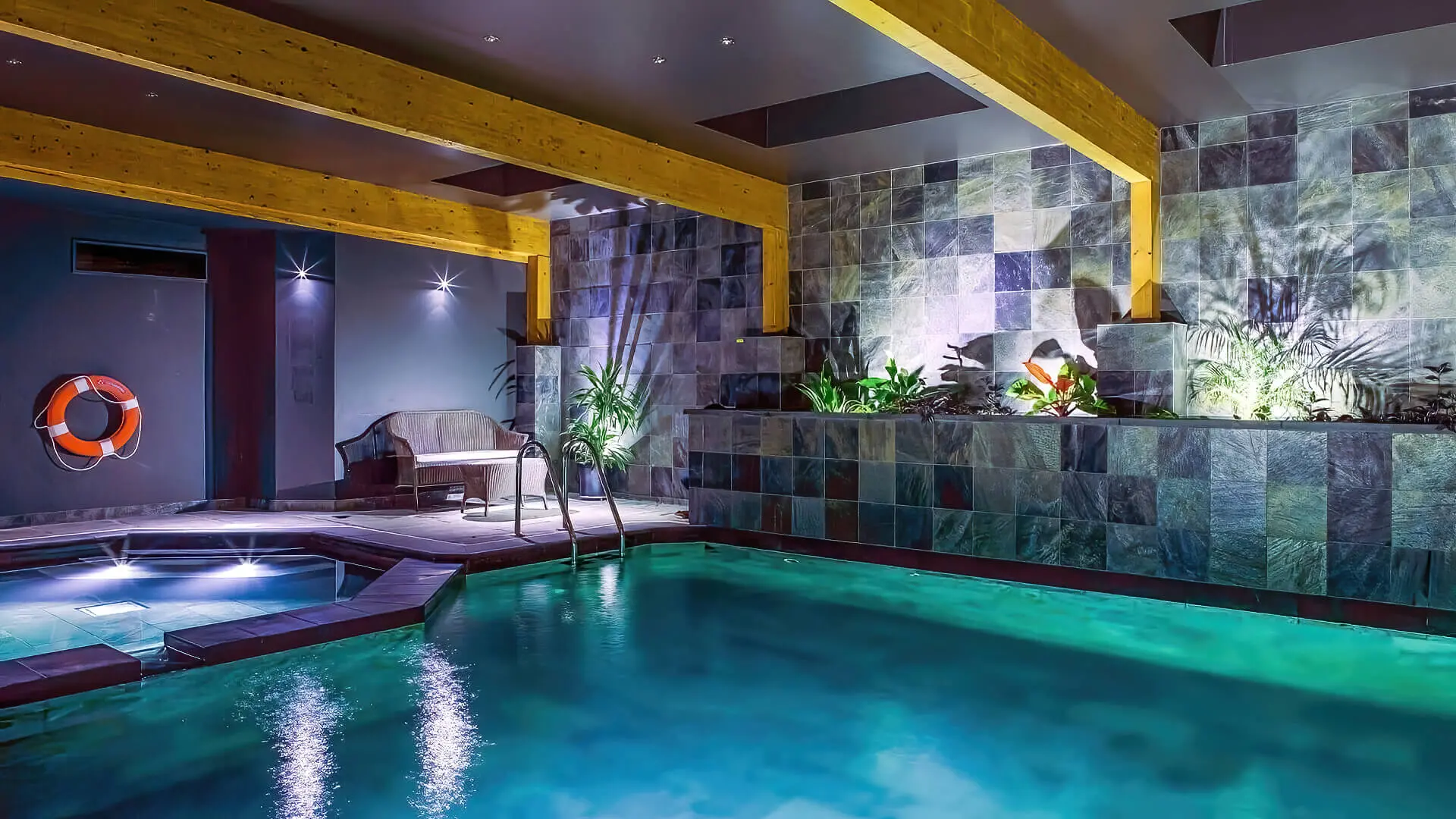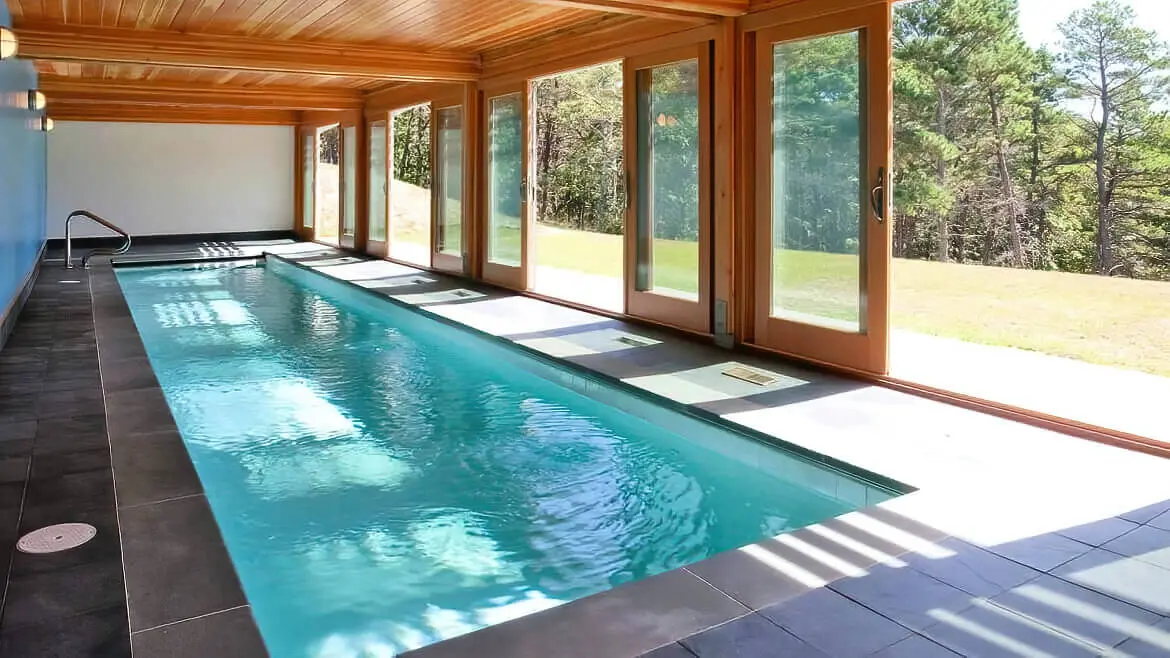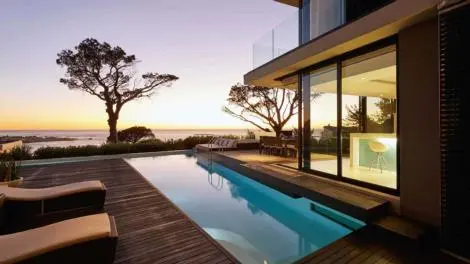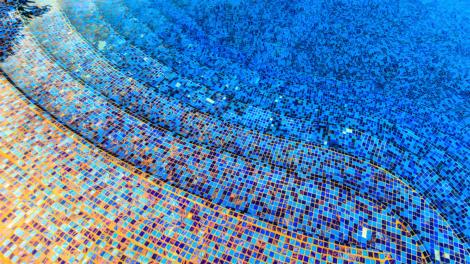Let’s agree that indoor pools are the ultimate form of luxury.
If you have the required space, then congratulations already! But as you may know, installing one isn’t something you can do immediately. There are various things to consider, from the type of pool to their installation charges, advantages and disadvantages.
So that you don’t have to spend hours searching for all the necessary information, here’s our comprehensive guide to indoor swimming pools.

What Are The Different Types Of Indoor Swimming Pools?
Before we walk you through the other details, it only makes sense to talk about the different types of indoor pools and offer an insight into their advantages and disadvantages. Generally, indoor pools are fibreglass, vinyl liners, and concrete pools.
1. Fibreglass Pools
Starting with fibreglass pools, the most significant advantage is that they can be installed relatively fast, have easy pool maintenance and have an exceptionally long-lasting service life. In hindsight, the nonporous fibreglass shell prevents the formation of algae, reducing the need for frequent sanitisation and chemical treatments. The smooth, non-abrasive surface facilitates optimum durability.
Fast and easy installation aside, a pool owner can incorporate features like steps, seats, beautiful water, and coloured finishes. However, the shipping restrictions mean that the overall shape and pool size aren’t very customisable. Other than that, the initial costs can be up to $10,000 more than different pool types.
2. Vinyl Liner Pools
A significant advantage of vinyl pools over fibreglass ones is that they are more affordable and offer more customisable options to suit different user needs. Like fibreglass, these pools have a nonporous and non-abrasive surface that checks algae growth in the water. Since there are no restrictions on the dimensions, the customisations are practically endless!
That said, certain disadvantages should be factored in. First, the thin vinyl liner measures 20 to 30 mm thick and will invariably deteriorate over time. Generally, it requires replacement after every 5-9 years, and the cost ranges from $2,500 to $3,500. This is also the reason why vinyl liner pools have lower resale values.
3. Concrete Pools
Concrete pools are a nice compromise between the other two types, combining durability and plenty of customisation opportunities. Concrete pool designs can include tanning ledges, beach entries, vanishing edges, etc.
However, unlike the other two types, the porous surface requires more chemical sanitisation and filtration. Depending on the size and features you opt for, the installation may take between 3 and 6 months. The concrete shell can be pretty alkaline, meaning the pool water will need added acid to counteract the rising pH level.
Not only that, but the maintenance costs can also increase considerably due to the increased algae formation. With resurfacing and other repair work every 10 or 15 years, the maintenance costs can range from $10,000 to $20,000.
How Much Do Indoor Swimming Pools Cost?
Now that you know the types of indoor pools, the next obvious question is, “How much does an indoor pool cost?” A typical pool may cost anywhere between $40,000 and $60,000. However, the cost may also be determined per square footage.
For instance, if the average cost of building an indoor pool structure is $100/ sq ft., and the area to be covered is 1,000 sq ft., the price will be $100,000. On top of that, you will most likely require a dehumidifier to protect the structure from moisture, which will cost an additional $20,000 to $30,000. Thus, the initial cost may start from $120,000 or more.
Furthermore, the cost may vary according to the type of pool and the related package. For example, a small self-installation fibreglass pool may cost between $9,000 and $13,000, minus the delivery charges, ranging from $600 to $2,500. That said, most still users save around $6,000 to $10,000.
On the other hand, assisted installation may range from $30,000 to $52,000, including the pump and filter system, plumbing and labour. Likewise, a standard fibreglass pool package will include specifics that vary from one company to another.
Lastly, turn-key fibreglass pool packages, where the pool builder handles everything from hiring the contractors to scheduling and overseeing the entire process, cost between $45,000 and $85,000 or more.
Concrete pools usually don’t have a self-installation package, and turn-key packages start from $50,000 and can go up to $100,000. But if you’re building your vinyl liner pool, you can get the job for under $20,000, while the packages range from $25,000 to $45,000, and turn-key packages cost between $35,000 and $65,000.
No matter the type, the lifetime maintenance, sanitation and renovation costs should also be considered before deciding on the suitable pool type for your needs and budget.
What Accessories Should You Consider?
Some of the essential accessories for indoor pools (irrespective of the type) are:

1. Automatic Pool Covers
That automatic covers are a must-have for indoor pools is a no-brainer. These accessories keep the water in the pool instead of the air by effectively preventing evaporation, resulting in optimum cost-effectiveness.
2. Pool Heaters
Since an indoor pool receives very little heat, you may consider getting a pool heater to keep the water comfortable throughout the year. In this regard, traditional indoor pool heaters are powered by natural gas or propane.
Can An Indoor Pool Be Enclosed Later After Building?
With thorough project planning, building an indoor pool now and enclosing it later is possible. By knowing the exact size of the desired enclosed structure, you can pour the footing for the future structure while the pool deck is poured. Aside from that, don’t forget to consider any future electrical or water features before running the deck.
Pros And Cons Of An Indoor Pool
Before wrapping up the guide, here’s a quick summary of the pros and cons of an indoor pool to help you make a well-informed decision.
Pros:
- Facilitates year-round swimming in all seasons
- Less debris and maintenance compared to outdoor pools
- Less chemical use as sunlight doesn’t interfere with sanitisers/chlorine
Cons:
- Relatively higher construction costs
- High energy cost in the absence of a natural heating source (sun)
- Not suitable for sunbathing
That’s All For Indoor Swimming Pools
That was all we had for today’s guide.
We hope our efforts have found the answer to all your questions about building indoor swimming pools. Since it’s costly, we’d strongly advise you not to rush through the process. After all, the last thing you’d want is to spend your hard-earned money for nothing!
Similarly, when choosing a pool installation company, conduct adequate research to ensure it offers the required services and is fully equipped. The company should have considerable experience and valid accreditations to operate in that region.
We will now take your leave. Till the next time, adios!



